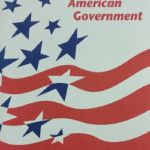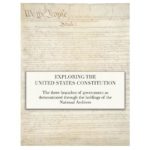Instead of placing authority in the hands of one person, like a king, or even a small group of people, the U.S. Constitution divides power. Power is first divided between the national, or federal government, and the state and local government under a system known as Federalism. At the federal level, the Constitution again divides power between the three major branches of our federal government: the legislative, the executive, and the judicial. Discover the battles of the branches in the National Constitution Center’s learning module.
Congress and the Separation of Powers – Virtual Exhibit
Why does the U.S. Constitution separate the government into three branches? At the nation’s founding, the Constitution’s framers understood that executive, legislative, and judicial responsibilities differed, and they provided for these distinct functions. They also believed that concentrating authority in one body would result in tyranny. They therefore divided the government into legislative, executive, and judicial branches, so that no single part would become too strong, and empowered each to limit or “check” the powers of the others. This exhibit examines Congress’s unique role and the ways in which it can balance or dynamically shape and challenge the powers of two other branches.
Connecting the Separate Powers
In this lesson, students will gain an understanding of the separation of powers using role playing and discussion. Students will identify which parts of the Constitution provide for the branches of our government, and will categorize public officials into one of these three branches.
Actions That Changed the Law
In 1998, when Lilly Ledbetter filed her complaint of wage discrimination against the Goodyear Tire and Rubber Co. with the Equal Employment Opportunity Commission, her goal was to get equal pay for equal work because that was the law. She had no idea that her decision would eventually involve all three branches of government and result in a law with her name on it – the Lilly Ledbetter Fair Pay Act of 2009.
Starter Kit: Checks and Balances Podcast
We exist in a delicate balance. Ours is a system designed to counterweight itself, to stave off the power grabs that entice even the fairest of us all. The U.S. government is comprised of humans, not angels, so each branch has the power to stop the other from going to far. The only catch being, of course, they have to actually exercise that power. In this episode, with the inimitable Kim Wehle as our guide, we learn what those checks actually are, and how the Executive, Legislative and Judicial branches (ostensibly) keep things democratic.
This short episode includes a one-page Graphic Organizer for students to take notes on while listening, as well as discussion questions on the back side.
Our American Government

Our American Government is a popular introductory guide for American citizens and those of other countries who seek a greater understanding of our heritage of democracy. The question-and-answer format covers a broad range of topics dealing with the legislative, executive, and judicial branches of our Government as well as the electoral process and the role of political parties. (House Document 108-94)
Exploring the United States Constitution eBook

Each chapter connects one or more of the billions of primary source documents in the holdings of the National Archives to the principles found in the United States Constitution. These documents exemplify the workings of the three branches of the federal government as laid out in our Constitution. This eBook is available as a Multi-Touch book for iPad and Mac on iTunes, or for PC, Android devices, Mac, iPhone, iPad, or eReader with Scribd.
Engaging Congress Game
To Understand a Scandal: Watergate beyond Nixon
Even today, four decades after the events, Watergate still symbolizes all that is, and might be, wrong with the workings of the federal government, elected officials and, ultimately, with the political system itself. Free registration for students and teachers required to access resource.
Ben’s Guide to the U.S. Government

Go on a learning adventure with Benjamin Franklin. Ben’s Guide is designed to inform students, parents, and educators about the workings of the Federal Government. Site content is divided into age levels. Lesson plans developed by the American Association of School Librarians are available, and games are also offered.
